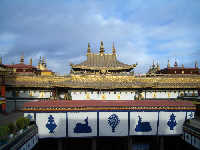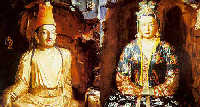|
Jokhang Monastery
( 2005-10-27 )
 The Jokhang Monastery, Da Zhao Si in Chinese, is located in downtownLhasaof Southwest China's Tibet Autonomous Region. It is a Buddhist hall for Tibetan Buddhists and a symbol of unity between the Tibetan and Han peoples. First built in the mid-7th century, the monastery was atemplein the shape of a two-story boat. After repeated expansion in the ensuing centuries, the monastery is now a combination of large buildings covering an area of 25,100 square meters. The Jokhang Monastery, Da Zhao Si in Chinese, is located in downtownLhasaof Southwest China's Tibet Autonomous Region. It is a Buddhist hall for Tibetan Buddhists and a symbol of unity between the Tibetan and Han peoples. First built in the mid-7th century, the monastery was atemplein the shape of a two-story boat. After repeated expansion in the ensuing centuries, the monastery is now a combination of large buildings covering an area of 25,100 square meters.
It is said that the monastery area was originally a huge lake. When Tubo King Songtsan Gambo marriedTang Dynasty(618-907) Princess Wencheng in 641 and the Nepalese Princess Khridzun, he built two monasteries respectively for them -- the Ramoche Monastery to house the statue of Sakyamuni (which equals the size of the Buddha when he was 12 years old) brought by Princess Wencheng, and the Jokhang Monastery to house the statue of Sakyamuni (which equals the size of the Buddha when he was 8 years old) brought by Princess Khridzun.
When the Jokhang Monastery was built, the monastery was named Rosa (Goats Temple), in memory of the goats that carried clay to fill up the lake for the monastery's construction.
 When Tang Princess Jincheng came to Tubo in the 8th century, she brought the statue of Sakyamuni (which Princess Wencheng brought to Tubo) from the Romache Monastery to the Jokhang Monastery; hence, the Jokhang Monastery became the worshipping center. Therefore, Rosa was renamed Lhasa, meaning "Holy Land of Buddha.'' When Tang Princess Jincheng came to Tubo in the 8th century, she brought the statue of Sakyamuni (which Princess Wencheng brought to Tubo) from the Romache Monastery to the Jokhang Monastery; hence, the Jokhang Monastery became the worshipping center. Therefore, Rosa was renamed Lhasa, meaning "Holy Land of Buddha.''
The Hall of Sakyamuni is the most important in the monastery. It enshrines a statue of Sakyamuni, which Tang Dynasty Princess Wencheng brought to Lhasa. The city is called Lhasa, meaning "holy land," because of the statue's presence. The statue attracts an endless flow of worshippers every day. Around the Hall of Sakyamuni are eight low-lying, dark halls where butter lamps flicker in front of Buddha images. These halls were all built during the Tubo Kingdom period.
|

